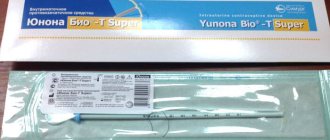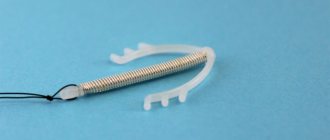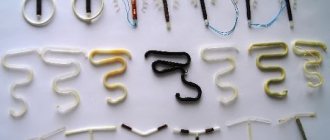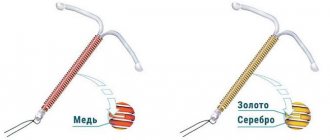What is a female spiral
The intrauterine device is the most popular and most effective type of female contraceptives at the moment. This phenomenon is explained quite simply: first of all, you just need to install this IUD and that’s it, next time you just need to remove it at the end of the period of use, that is, you don’t have to constantly worry about not missing or forgetting to take it for contraception, as is the case with hormonal pills. And of course, the IUD is very effective and reliably protects against unwanted pregnancy.
There are two types of intrauterine devices: hormonal (Mirena) and containing metal; as a rule, they are coated on top with copper, silver or gold. The intrauterine devices themselves have a size of 3x4 centimeters, in most cases they look like the letter “T”, since this is the shape that is closest to the structure of the uterus. They themselves are either plastic or plastic with metal. And women often ask questions that concern them, what happens to their periods after the installation of an IUD and after its removal. Let's look at these questions in more detail.
Cycle recovery after IUD
After removal of the IUD, your period may come exactly on schedule. But in most cases, a recovery period is required during which they are absent. It can last up to several months. Although, in the absence of additional negative factors, the delay in menstruation after the IUD is no longer than 2 weeks.
Experts associate longer waiting times with:
- Duration of wearing the device;
- The age of the woman;
- Type of Navy. Hormonal ones usually require a longer recovery period than other contraceptives;
- Level of endometrial thinning;
- Stress caused by both the abolition of contraception and the anxiety associated with the manipulation;
- Associated ailment. Both hormonal and inflammatory diseases affecting the genital area can have an impact.
A woman sometimes has to solve the problem “I took off the IUD, no period.” This is possible both for the reasons mentioned and because of pregnancy.
If the IUD was removed before ovulation, and before this procedure the woman was sexually active without any other protection, conception is very possible. An ectopic pregnancy is no less likely.
In some women, due to existing diseases and past surgical interventions, the IUD increases the risk of its occurrence. Therefore, the test will not be superfluous.
We recommend reading the article about the nature of menstruation when taking birth control pills. Find out about the effect of contraception, the reasons for changes in the menstrual cycle, and medications recommended by doctors.
Heavy menstruation
The first period after the IUD normally comes within 30-40 days. They may be delayed for the reasons mentioned above, or when the IUD was removed urgently. Menstruation can be heavy, which is associated with hormonal imbalances.
The spiral for a long time interfered with the normal development of the endometrium and prevented the maturation of the egg. This could not but have an impact on the functioning of the ovaries. Discharge becomes intense due to:
- Inflammation arising in the reproductive system. In most cases, it is the culprit, so it is important to monitor the cycle in collaboration with a doctor;
- Damage to the uterus. The process of removing an IUD is much simpler and shorter than insertion, but injury is still likely. It happens that parts of the contraceptive remain inside the organ. In this case, discharge will be observed from the very beginning after removal. And the pain, which normally should go away soon, will remain for a long time and may intensify.
How menstruation goes after the IUD depends on the diseases the woman has. In some of them, the IUD is prescribed not only as a means of preventing pregnancy, but also as a treatment for existing menorrhagia or prerequisites for the occurrence of endometrial hyperplasia.
When the IUD is removed, menstruation may return to its previous form due to the fact that the factors that provoke the abundance of discharge are again in force.
Removing the IUD and scanty periods
More often, women report scanty periods after the IUD. The arrival of such menstruation can be explained by natural causes. The development of the endometrium has been suppressed for a long time; it is unrealistic that it, like the functioning of the ovaries, will be restored in one cycle.
If, after 3 periods, menstruation looks more like spotting, this means a serious hormonal imbalance that needs to be treated. Otherwise, a woman will have difficulty conceiving.
Normally, menstruation after an intrauterine device should return to its previous characteristics that were observed before its use. Due to the long-term effect of the contraceptive on the reproductive organs, this may not fully occur.
Advantages of the uterine device
The IUD has many advantages:
- Small price.
- After removing the IUD from the body, reproductive capacity is quickly restored.
- Can be used even while breastfeeding.
- A very high degree of contraception, can be compared with a condom, as it prevents unwanted pregnancy by 98%.
- Unlike the same hormonal pills, a woman’s hormonal levels do not change
- The spiral can be taken for a very long time, from 3 to 10 years.
- Installation and removal is straightforward.
- It does not cause discomfort and is not felt either in everyday life or during sexual intercourse.
- There is no need for oral contraceptives.
Possible side effects
Any IUD is a foreign body for the body. Therefore, after its installation, unwanted reactions may occur. Common side effects include the following:
- the occurrence of pain in the lower abdomen after installation of the IUD;
- spiral loss;
- increased heaviness and pain of menstruation.
Some women experience other undesirable consequences of having the Juno IUD installed. Less than 1% of patients develop inflammation of the reproductive organs. It manifests itself with the following symptoms:
- the appearance of unusual vaginal discharge with an unpleasant odor;
- burning, itching in the vagina;
- nagging pains that are concentrated in the lumbar region and lower abdomen;
- disturbance of the regularity of menstruation, the appearance of acyclic bleeding;
- temperature increase.
In very rare cases, heavy uterine bleeding occurs. Their appearance can be caused by perforation of the uterine wall, an individual reaction of the body, or the growth of a benign tumor - fibroids.
Comment! Less than 2% experience pain during sexual intercourse and problems achieving orgasm.
Classification of uterine devices
When choosing an intrauterine device, the doctor relies on the physical condition of the patient and the unique structure of the uterus. There are now more than 50 different types of devices. They were not improved immediately, but gradually, so intrauterine devices have 4 generations at once. Let's look at them all in more detail.
- 1st generation. Inert. These are the very first intrauterine devices; they were invented about a century ago. Of course, these are the very first coils, and therefore have very low efficiency, and can easily move or even fall out, which is why such devices have been banned in many countries around the world. The brightest and most famous representatives: the Lipps loop, made of plastic in the shape of the English letter S; Mauch's ring, made of steel and has two scrolls; Saf-T-Coil spiral, double; Dalkon's shield.
- 2nd generation. Copper. A semi-oval or T-shaped device, the main rod is wrapped around a copper wire. It is very easy to put on and take off. Due to the presence of copper, an acidic environment is formed in the uterus, which kills all sperm activity. Such contraceptives are prescribed for a period of 3 to 5 years. The most popular models of spirals are: Multiload, Nova T, Juno Bio and Para Grand.
- 3rd generation. Silver. To extend the service life of contraceptives and delay the oxidation of the metal, in the third generation of IUDs they began to use silver instead of copper. But these are not all the advantages of silver IUDs over copper ones. Improved spirals have even stronger protection and, in addition, silver ions have a beneficial effect on the female body, as they have an antibacterial and disinfectant effect. Contraceptives made of silver or silver with an admixture of copper have a validity period of 5 to 7 years. Gold intrauterine devices also belong to the 3rd generation and are an alternative to silver and copper IUDs and are an improved version of them.
- 4th generation. Hormone-containing. Doctors consider this generation of IUDs the best remedy for unwanted pregnancy. These spirals are also shaped like the letter “T”, but on its stem, instead of a metal spiral, there is a hormonal drug, progesterone or levonogrestrel, and it is gradually and evenly released into the uterus. This method of contraception has no contraindications, because the hormones do not reach the blood, having only a local effect, slowing down ovulation, while relieving inflammation, and, of course, does not allow you to get pregnant. These IUDs are used for only 5 or maximum 7 years.
Kinds
You can find several types of Juno spirals on sale. But before buying, you need to visit a gynecologist and together choose the most suitable model.
The doctor may recommend one of these Juno spirals:
- Bio T;
- Bio T with silver;
- Bio Multi;
- Bio T Super;
- Bio Multi Ag;
- ring-shaped;
- with gold.
They differ in form, composition and duration of the contraceptive effect.
Juno Bio T
The most budget option is the Juno Bio T IUD. In appearance, it looks like an anchor. In the production of this model, an inert material is used - plastic. It is covered with thin copper wire, under the influence of which an acidic environment is created in the uterus.
You can buy a T-shaped model of the Juno spiral in many pharmacies. It is established for a period of up to 5 years.
Juno Bio T Super
The Bio T Super model differs from the classic version of the spiral due to the inclusion of antimicrobial components. It is treated with a special antibacterial agent made from propolis.
When using this option, the likelihood of developing inflammatory processes in the organs of the reproductive system is reduced. Juno is installed for 5 years. The contraceptive effect is achieved due to mechanical irritation of the walls of the uterus and the effect of copper wire on sperm.
Spiral Juno Bio T with silver Ag
The Bio T model with silver is no different in shape from standard models. This is a T-shaped spiral, the efficiency of which is higher compared to conventional types. Her leg is wrapped in copper and silver wire. Thanks to this combination, the likelihood of copper oxidation is reduced.
The validity period of Juno Bio T Ag, which contains silver, is 7 years.
Spiral Juno Bio Multi
The Juno spiral model, called Bio Multi, has an F-shape. Its stem is coated with copper, which helps create an acidic environment in the uterus and increase the contraceptive effect. There are teeth along the outer edge of the spiral.
The size of the Juno Multi spiral is larger compared to T-shaped models. Gynecologists recommend it to women who have had multiple abortions or have given birth to several children. This model can be used by patients who have had cases of IUD prolapse.
Spiral Juno Bio Multi Ag
For women who have given birth, spirals made in the shape of the letter F are suitable. The manufacturer managed to increase the contraceptive effect of the classic Juno Bio Multi IUD by adding silver to its composition.
The contraceptive effect of the Juno Bio Multi Ag intrauterine device is 7 years.
Juno spiral annular
Standard T-shaped IUDs are not recommended for use by girls who have not yet given birth. If they want to use spirals for contraception, then gynecologists recommend that they choose ring-shaped models.
For nulliparous girls, the manufacturer recommends using Juno with a diameter of 18 mm. For patients who have already given birth, a model with a diameter of 24 mm can be installed. Each of these options contains copper.
Comment! The validity period of intrauterine rings is 5 years. The ring-shaped Juno spiral with silver is considered more effective. It is established for a period of up to 7 years.
Juno spiral with gold
For patients who are allergic to copper, Juno Bio T Au can be installed. This option has a higher price compared to other models, but the likelihood of complications when using it is minimal.
Practice shows that Juno with gold in its composition is not rejected. When used, an anti-inflammatory effect on the body is observed.
Spiral shapes
It is impossible to say which form of the spiral is more effective; the type of spiral is chosen according to the woman’s preferences and on the advice of the doctor due to the unique structure of the uterus, which, of course, is the most important thing when choosing a form.
There are only three main forms of the IUD, and each of them has its own characteristics:
- T-shaped. This form of IUD is the most popular among the female population. They themselves are very convenient and are also easy to install and remove. This IUD looks like a rod from which two flexible tendrils, or shoulders, extend. Due to these hangers, the spiral is attached inside the uterus. A thread is attached to the bottom of the rod, with which the gynecologist can remove the spiral.
- In the form of a ring. A modern form of IUD, which is recommended primarily for women who have had an abortion. It is made of plastic and contains silver, gold or copper. This IUD attaches well to the uterus and is also easy to remove, and therefore the presence of a string on them is not mandatory.
- Loop or umbrella. The umbrella-shaped dome on the outside has notches, similar to spikes, with their help the IUD is attached to the uterus, without threatening to fall out at the wrong moment. This type of IUD is usually used when the uterus has a non-standard shape, into which it is impossible to install the most common T-shaped intrauterine device.
The effect of the IUD on the reproductive system
The intrauterine device is a reliable and popular method of contraception among women who have given birth. Protection against pregnancy is carried out in the following ways:
- Aseptic inflammation in the uterine cavity. The IUD is installed under sterile conditions, the likelihood of infection is minimal. However, even in such cases, aseptic (without pathogenic bacteria) inflammation begins in response to a foreign body in the uterine cavity. As a result, a layer of defective cells forms on the inner surface of the uterus, which prevents the implantation of the fertilized egg if fertilization does occur.
- Effect on sperm. A foreign body in the uterine cavity is a mechanical obstacle to the further advancement of male germ cells.
- The contractility of the uterus increases. The intrauterine device, being in the uterine cavity and irritating its walls, stimulates the activity of the myometrium. This can be expressed in periodic nagging pain in the lower abdomen. In addition, this mechanism prevents the implantation of the fertilized egg into the endometrium.
There are also spirals with metal additives - copper, gold, silver. They have an additional effect and increase the contraceptive effect. In particular, copper-containing IUDs interfere with the activity and motility of sperm, thereby reducing the chances of pregnancy.
In addition, copper ions can influence the peristalsis of the fallopian tubes, which reduces the likelihood of developing an ectopic. Spirals based on silver and gold are more preferable to women who have once suffered from inflammatory processes of the genital organs - endometritis, adnexitis, cervicitis and others.
However, all these are only hypothetical effects of the IUD on a woman’s body. How they prevent pregnancy has not been fully studied. However, even in ancient times, to protect against pregnancy, women placed a spool - a ring of gold - into the uterine cavity immediately after childbirth. Thus, peculiar spirals existed back in Ancient Egypt.
The most popular spirals
Let's take a closer look at the most popular intrauterine devices among women:
- Mirena is a hormone-containing IUD that is considered the most effective of its kind. It is a T-shaped intrauterine device. The cost of Mirena ranges from 7 to 10 thousand rubles.
- Multiload is an umbrella-shaped IUD containing copper winding. It can also be installed on girls who have not yet given birth. It costs from 3.5 thousand rubles.
- Nova T. As the name suggests, this IUD is also T-shaped. They have a copper winding; in more expensive versions it contains an admixture of silver. Cost from 2 thousand rubles.
- Juno is a Belarusian IUD, of which there are many different variations for already established mothers, and for girls who have not yet given birth. The price range varies from 250 to 1 thousand rubles.
Analogs
You can replace Juno with other intrauterine devices at the request of the woman or the doctor’s recommendation. The patient can buy the IUD Vector, Nova or Multiload.
For medicinal purposes, other types of intrauterine contraceptives are used - hormonal devices.
Which spiral to choose: Juno or Vector
When selecting an intrauterine contraceptive device, you should focus on the shape of the product and the metal used. In terms of efficiency and range of IUDs, Juno and Vector are practically the same. Women who have used spirals of these brands note that side effects in the form of increased pain and profuse menstruation are observed only 1-6 months after installation. Over time, the condition returns to normal.
The Juno IUD is produced by the Belarusian company, and the Vector IUD is produced by Vector CJSC. These companies produce products with copper, silver and gold wire in a T- or F-shape.
Which coil is better: Juno or Multiload
The Multiload spiral is available only in the form of the letter F with spikes on the outside. It is suitable for women who have given birth and patients who have had several abortions in their history. But the cost of such a spiral is higher compared to Juno and Vector.
Gynecologists recommend installing Multiload for those women whose uterine length, according to ultrasound results, is more than 6 cm. The operating principle of the Juno and Multiload spirals is the same. They have a spermicidal effect, irritate the uterus, preventing implantation of the fertilized egg, and prevent the endometrium from growing.
Attention! If a gynecologist recommends a ring-shaped device for a nulliparous girl with a diameter of 18 mm, then such a model is only available in the Juno line.
Disadvantages and side effects of intrauterine devices
Spirals, of course, have disadvantages, and there are only three of them:
- with the IUD, unlike using a condom, there is no protection against sexually transmitted infections;
- Only a doctor can insert and remove the spiral;
- After installation of an intrauterine device, side effects may occur.
Intrauterine devices are one of the safest contraceptives in terms of side effects, since in 95% of cases the use of an IUD occurs without any complications. However, extremely rarely, the development of endometritis and uterine perforation can still occur.
Advantages and disadvantages of Juno Bio-T spirals
Like other models of intrauterine contraceptives, the Juno Bio-T IUD has its pros and cons.
The advantages include:
- long-term contraceptive effect;
- no effect on hormonal levels and libido;
- high protection against unplanned pregnancy;
- Possibility of use during breastfeeding;
- low risk of side effects;
- Ease of use;
- saving money compared to other methods of protection.
Disadvantages of intrauterine contraception:
- installing an IUD increases the risk of infection of the genital tract;
- risk of ectopic pregnancy;
- lack of protection against STIs;
- increased abundance of menstrual flow;
- the likelihood of the IUD falling out.
When choosing this method of protection, you need to take into account all the pros and cons, as well as possible complications after installing the IUD.
Contraindications
There are cases when the installation and use of an IUD is contraindicated:
- If you suspect pregnancy.
- You have several sexual partners.
- If you have an acute disease of the cervix or pelvic organs, including STIs.
- If inflammation of the pelvic organs has been observed in the last three months.
- For vaginal bleeding not associated with menstrual bleeding.
- For uterine fibroids, which are growing rapidly, if the myomatous node has deformed the shape of the uterus.
- For genital cancer.
- For severe anemia.
- At high risk of contracting an STI.
Delayed menstruation
The shift in critical days can be by 1–2 weeks, sometimes menstruation is absent for up to 1–2 months. In all cases, after 10–12 days of a missed period, a pregnancy test should be performed, since a small probability of conception remains.
In addition to a normal pregnancy, an ectopic pregnancy is also possible, which poses a great threat to the health and life of a woman.
Situations in which there are no periods for a long time after removal of the IUD may signal the development of a hormonal imbalance or an inflammatory disease. If the delay occurs due to adhesions or inflammation of the appendages, it is accompanied by pain in the abdominal cavity. With the penetration and development of infections, purulent discharge from the genital tract, a feeling of itching, and severe discomfort may appear.
Preparing the body for installation of the spiral
First of all, preparation begins with a visit to a gynecologist, who will look at the general state of health, the indications and contraindications associated with the installation of the IUD, possible side effects, installation time and various other nuances. Before installing the IUD, there must be no sexual intercourse for at least 24 hours. Do not douche or use any chemical intimate hygiene products. And also two days before the installation of the IUD you cannot use:
- ointments;
- creams;
- aerosols;
- tablets;
- vaginal suppositories.
If you have the slightest suspicion of pregnancy, you should definitely take a test. If the result is positive, the doctor has the right to refuse to install the IUD. If the result is negative, you should also take a smear to check for diseases or sexually transmitted infections.
If the woman is healthy and not pregnant, the doctor may install an IUD. It is easiest to insert the IUD two to three days before your period, because at this time the cervix is maximally dilated.
After the examination, the gynecologist fixes the cervix with a special device and inserts the spiral. Not often, but it happens that this procedure is accompanied by sensations like before menstruation, which pass quite quickly. To avoid any infection, the doctor prescribes antibiotics.
To make sure that the spiral remains securely attached, preventive examinations are scheduled: a month after installation, then six months later, and then once a year.
Mandatory rules of behavior after installation of the IUD that must be followed for the first 5 days:
- exclude sexual contacts;
- avoid douching;
- refrain from taking a hot bath;
- you can’t lift heavy things or play sports;
- do not take medications containing acetylsalicylic acid;
- in any emergency, immediately contact your treating gynecologist;
- It is not advisable to use tampons during menstruation; it would be best to choose pads.
Instructions for use
Juno intrauterine devices are recommended for use in patients who have already given birth as a long-term means of protection against conception. The contraceptive is installed after a gynecological examination on days 4-8 of the cycle. During this period, the procedure is less painful due to the slightly open cervical canal.
The installation is performed by a gynecologist on an outpatient basis. For quick insertion, a special conductor is included with the Juno Bio-T IUD. After antiseptic treatment of the patient’s genitals, the doctor fixes the lip of the uterine cervix with a medical clamp, measures the depth of the organ and introduces a contraceptive. Upon completion of the procedure, the gynecologist trims the control threads of the spiral to 3-4 cm. All manipulations take about 10 minutes.
In the first week after installation of the Juno Bio-T IUD, a woman must observe a number of restrictions:
- refuse sexual intercourse;
- limit physical activity;
- do not use tampons and vaginal suppositories.
If after the introduction of a contraceptive the patient experiences nagging pain and discomfort in the abdominal area, she can take an antispasmodic. Normally, these symptoms go away after a couple of days. If the pain intensifies, the temperature rises, or chills appear, you should immediately seek medical help to urgently remove the device.
The spiral is removed after expiration or at the request of the patient. Sometimes the contraceptive is removed ahead of schedule for medical reasons due to the development of gynecological diseases and other complications. To control the location of the contraceptive, a woman needs to be regularly observed by her treating gynecologist. After installation, the doctor will familiarize the patient with the schedule of visits and give recommendations on the use of the IUD.
Menstruation after installation of the IUD
In fact, everything will depend on the installed spiral. For example, with the introduction of metal-containing IUDs, menstruation will change as follows:
- the amount of blood released increases, and the duration of menstruation also increases. Often, but not always, women notice that pain increases during menstruation;
- before menstruation, after and between menstruation, bloody spotting begins to appear.
But don’t be scared, because these unpleasant symptoms appear only from three to six months from the moment of installation. Then they pass, and the menstrual cycle returns to normal. But if menstruation with the IUD comes irregularly, and severe pain occurs, then the IUD must be removed urgently.
The nature of menstruation after the installation of a hormonal IUD in most cases is fundamentally different from the changes that occur after the installation of non-hormonal ones containing metal. Most often, menstruation becomes shorter in time, and the discharge itself becomes more scanty. Often women notice delays, and in 20%, periods disappear altogether. This happens because the IUD, which contains hormones, suppresses the development of mucous tissue in the uterus.
Don’t be alarmed; your periods will return after the IUD is removed from the body. These changes are actually harmless; on the contrary, they improve a woman’s life. For example, the Mirena hormonal device is used to treat intrauterine bleeding.
Dates of menstruation with an IUD
Menstruation during the spiral should normally come on schedule. But since the body has suffered stress associated with its introduction, and also needs to adapt to the presence of a foreign object in the uterus, a slight delay is acceptable. It is also made possible by a shock to the nervous system, which provides hormonal accompaniment of the cycle.
In this case, if there is a spiral, a delay in menstruation is likely due to a deficiency of certain substances, which causes a prolonged wait. Its increase is facilitated by installation outside critical days. But the wait for menstruation should not be longer than 3 weeks. And when it exceeds this period, the woman urgently needs to see a doctor.
A short delay in menstruation with the IUD is not an alarming signal if it is observed only for 3-4 cycles. The period of adaptation may well be that long. When this happens for longer, it makes sense to consult a specialist.
If a woman has an IUD and has not had her period for a long time, then it is possible that conception has occurred. This probability is very small, but it should not be denied at all.
This also requires immediate consultation with a specialist. To avoid this, you should use other methods of protection for a couple of weeks after inserting the IUD.
First menstruation and IUD: nature of discharge
The nature of menstruation in most women changes towards increased discharge and duration. The spiral makes heavy periods possible due to the irritating effect on the endometrium and changes in the composition of cervical mucus.
We must also not forget about unstable hormonal levels due to installation-related stress. The spiral makes the first menstruation be especially intense. A woman may need more than 1 pad for 3-4 hours. If she also feels severe pain and severe weakness, she may need medical help immediately.
But normally, menstruation, although it goes beyond what is usual for a particular woman, does not pose any danger. And even if the pain is stronger than before, it is relieved with antispasmodics.
If there is no effect from the medications, cramping sensations, or severe bleeding with blood, you should consult a doctor immediately. This could mean severe inflammation, the body’s rejection of the IUD, or injury to the uterus. The spiral must be removed immediately.
During the remaining days of your period immediately after inserting the IUD, you should not use tampons. They increase the risk of infection in the internal genital organs and may interfere with adaptation to the spiral.
Installed intrauterine device
Through the cycle after installation
Gradually, the body restores hormonal balance, which brings menstruation after the introduction of the IUD to the usual norm for a particular woman. If their intensity remains at the level of the first menstrual cycle, this may indicate that the body does not accept this method of contraception or type of contraceptive.
When your period takes a long time, the IUD was installed 1-3 months ago, there is nothing to worry about. This is a normal reaction of the reproductive system to a foreign object inside the uterus. Between menstruation at this stage, spotting with blood is possible. For now, this is also a sign that the reproductive system is getting used to the contraceptive. You shouldn't feel any pain.
3 months after insertion of the IUD
At this stage, menstruation after installation of the device returns to the physiological norm. They may still be more abundant than usual, but they do not fall outside the acceptable range. Pain during menstruation also sometimes remains stronger than what was felt before the insertion of the IUD.
After the IUD, heavy periods and long periods of time during its 3-month stay in the uterus require consultation with a specialist. Most likely, the IUD will have to be removed, since the side effects from its presence exceed the contraceptive effectiveness. A woman may develop anemia and inflammation of the genital area.
Despite the reliability of the IUD, it happens that the IUD remains in place for 3 months and there are no periods at any stage, although they came immediately after insertion. Pregnancy in this case is possible even now, when the body, it would seem, has already adapted to the adaptation. The location of the fertilized egg outside the uterus is also possible.
We recommend reading the article about painkillers during menstruation. You will learn about the nature of pain and its causes, ways to prevent it, and effective medications.
Reviews of the Juno spiral
You can understand how effective various types of Juno intrauterine contraceptives are from the reviews of women who have used them.
Reviews of the Bio T intrauterine device
Alla Ryaboshtanova, 32 years old, Murmansk
After the birth of my 2nd child, I decided to have an IUD installed. The gynecologist advised not to spend money and buy the simplest model Juno Bio T with copper. After installation, my stomach hurt all day, but the next morning the condition returned to normal. Menstruation has become longer; instead of the usual 4-5, it lasts 7-8 days.
Molchanova Vera, 27 years old, Korolev
I installed the spiral 4 years ago – a year after the birth of my daughter. I didn’t notice any side effects that the doctor warned about. This year I plan to take it out, but I won’t change it for now. My husband and I decided to have a second baby.
Reviews of Juno Bio T Ag with silver
Suprun Karina, 34 years old, Rostov-on-Don
At a family council, my husband and I decided that we don’t want to have more children, so we need to choose a reliable method of contraception. The doctor advised to install the Juno Bio T Ag IUD. Judging by the reviews I've read, this is an inexpensive but reliable spiral.
Larushko Marina, 29 years old, Kursk
I have already installed Juno Bio T with silver wire 2 times in a row. The first time it lasted for 6 years, there were no problems with its use: no side effects, no unwanted pregnancies. 4 months after the extraction I managed to get pregnant. Now six months have passed since giving birth, I decided to return to my favorite method of contraception.
Reviews of the Juno Bio Multi spiral with silver
Mulko Svetlana, 37 years old, Krasnodar
With my 3rd child I decided to stop and put on a spiral. The gynecologist advised me to buy not a standard T-shaped model, but an IUD made in the shape of the letter F with spikes along the outer edge. As evidenced by reviews of the specified intrauterine device Juno Bio Multi Ag, it reliably protects against unwanted pregnancies.
Andreeva Ekaterina, 35 years old, Ekaterinburg
To reduce the risk of side effects from the IUD, the gynecologist advised placing Juno Bio Multi. After installing the intrauterine device on the 3rd day of the cycle, menstruation seemed to start again. They walked for another 5 days. Menstruation has now become more painful and protracted, but the doctor promises that everything will return to normal within six months.
Reviews of the O-shaped Juno spiral
Chekantseva Anna, 23 years old, Cheboksary
Last year I got married and thought about changing the method of birth control - I don’t like using condoms all the time, I’m afraid of hormonal pills, and I don’t want to get pregnant yet. During the examination, the gynecologist, when asked about contraception, suggested the ring-shaped Juno. Its installation is a painful procedure, despite the use of an anesthetic. But now I don’t have to worry about pregnancy.
Derkach Yulia, 33 years old, Lipetsk
On the doctor’s advice, I installed an O-shaped Juno IUD with copper. Immediately after installation I felt weak, but a day later my condition returned to normal. The IUD has been in place for 2 years now and has not caused any problems.









